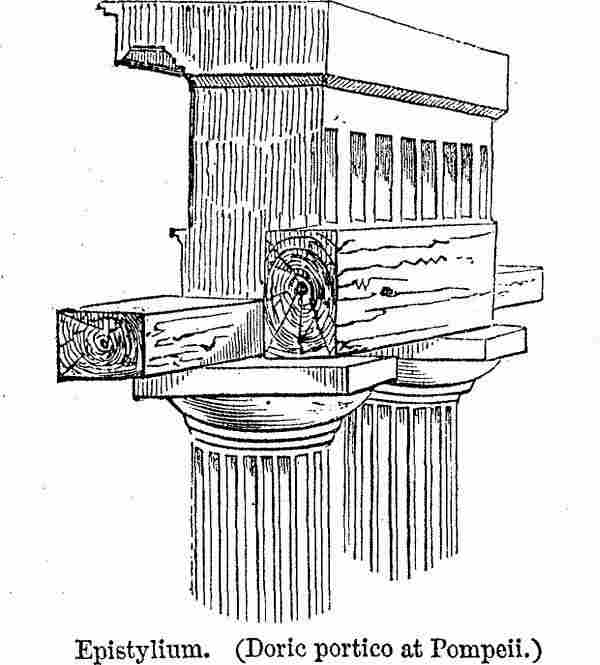.
EPISTY´LIUM (ἐπιστύλιον) is properly, as the name implies, the architrave, or lower member of an entablature, consisting of one or several beams (in Parthenon, three), resting upon the capitals. Its function is to bind the columns of the peripteron into a whole, and to distribute the weight of the superstructure (Plut. Per. 13; Paus. pass.; Varr. R. R. 3.2; Festus, s. v. For epistylium applied where there are only half-columns: Choisy, Étudces épigr. sur l'Archit. grecque; cf. COLUMNA). The component blocks were fastened together and to the capitals by iron clamps; in the Parthenon, further, at the corners (Adamy, Architekt. 3.126; figs. 37, 38). Rules for the height of the epistylium are given by Vitruvius (3.3, s. 5, ed. Schn.). In the best examples of the Doric order the front of the architrave was a plain flat surface without carving, but sometimes ornamented with metal shields affixed above each column, as. in the Parthenon, where there are also inscriptions between the shields (v. Lucas' model). In the Ionic order, where the epistylium scarcely differs from the frieze, it was cut up into two or usually three slightly overlapping surfaces (fasciae), and finished off above with astragal, cymatium, and, in Asia, lysis; in Attica, a simple abacus (Adamy, pp. 253, 275; see woodcuts under COLUMNA p. 492). In Asia, the underside of the epistylium exhibits a hollow containing a cymatium (Adamy, fig. 117A); in Attica perhaps the same was painted. In the Ionic style, the frieze might be wanting, and the γεῖσον rest directly on the epistylium (so in the south prostasis of the Pandrosos Cella, and the temple of Athene [p. 1.751]at Priene, according to Bötticher). In the Corinthian style the arrangement was similar to that in the Ionic, only the triple division was marked by pearl-beading or a cymatium. Originally the architrave was the main beam, laid along the top of the columns to support the roof. When stone was used, a natural limit was set to the length of the blocks, and consequently the distance of the columns, by the impossibility of obtaining pieces of stone or marble beyond a certain size. In the temple of Artemis at Ephesus the blocks were so large that it was a wonder how they could have been raised to their places; Pliny describes the process (H. N. 36.96). When an intercolumniation was of the kind called “araeostyle,” that is, when the columns were more than three diameters apart, the epistylium was necessarily made of wood instead of stone (Vitr. 3.2, s. 3.5, ed. Schn.); a construction exemplified by the restoration in the annexed woodcut

Epistylium. (Doric portico at Pompeii.)
(Pompeii, vol. i. p. 143) of the Doric portico, which surrounds three sides of the forum at Pompeii. The holes seen at the back of the frieze received the beams which supported an upper gallery. Epistylium was sometimes used for the whole of the entablature.
Dictionary of Greek and Roman Antiquities
| Ancient Greece
Science, Technology , Medicine , Warfare, , Biographies , Life , Cities/Places/Maps , Arts , Literature , Philosophy ,Olympics, Mythology , History , Images Medieval Greece / Byzantine Empire Science, Technology, Arts, , Warfare , Literature, Biographies, Icons, History Modern Greece Cities, Islands, Regions, Fauna/Flora ,Biographies , History , Warfare, Science/Technology, Literature, Music , Arts , Film/Actors , Sport , Fashion --- |


